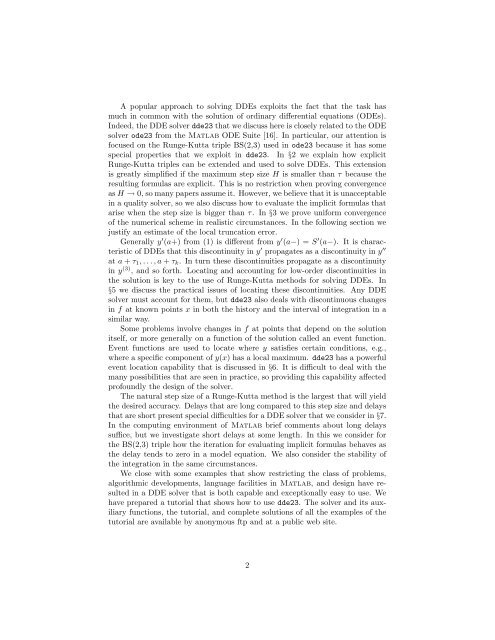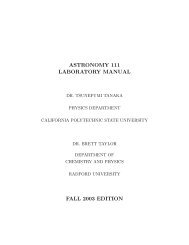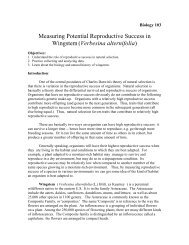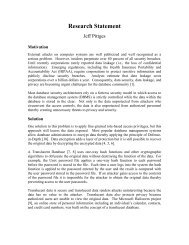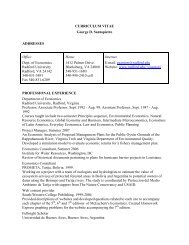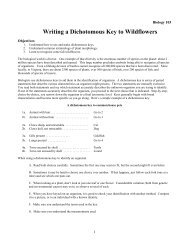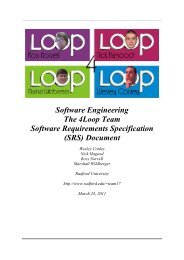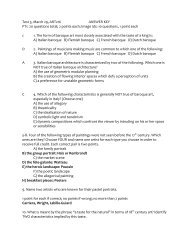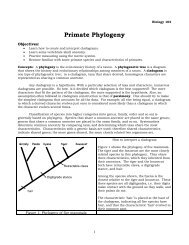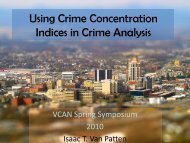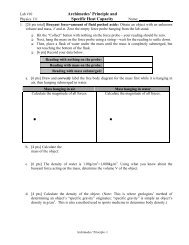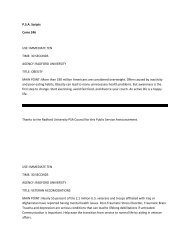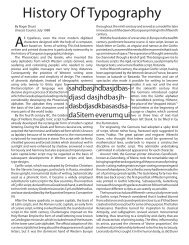Solving DDEs in Matlab - Radford University
Solving DDEs in Matlab - Radford University
Solving DDEs in Matlab - Radford University
Create successful ePaper yourself
Turn your PDF publications into a flip-book with our unique Google optimized e-Paper software.
A popular approach to solv<strong>in</strong>g <strong>DDEs</strong> exploits the fact that the task has<br />
much <strong>in</strong> common with the solution of ord<strong>in</strong>ary differential equations (ODEs).<br />
Indeed, the DDE solver dde23 that we discuss here is closely related to the ODE<br />
solver ode23 from the <strong>Matlab</strong> ODE Suite [16]. In particular, our attention is<br />
focused on the Runge-Kutta triple BS(2,3) used <strong>in</strong> ode23 because it has some<br />
special properties that we exploit <strong>in</strong> dde23. In §2 we expla<strong>in</strong> how explicit<br />
Runge-Kutta triples can be extended and used to solve <strong>DDEs</strong>. This extension<br />
is greatly simplified if the maximum step size H is smaller than τ because the<br />
result<strong>in</strong>g formulas are explicit. This is no restriction when prov<strong>in</strong>g convergence<br />
as H → 0, so many papers assume it. However, we believe that it is unacceptable<br />
<strong>in</strong> a quality solver, so we also discuss how to evaluate the implicit formulas that<br />
arise when the step size is bigger than τ. In §3 we prove uniform convergence<br />
of the numerical scheme <strong>in</strong> realistic circumstances. In the follow<strong>in</strong>g section we<br />
justify an estimate of the local truncation error.<br />
Generally y ′ (a+) from (1) is different from y ′ (a−) = S ′ (a−). It is characteristic<br />
of <strong>DDEs</strong> that this discont<strong>in</strong>uity <strong>in</strong> y ′ propagates as a discont<strong>in</strong>uity <strong>in</strong> y ′′<br />
at a + τ1, . . . , a + τk. In turn these discont<strong>in</strong>uities propagate as a discont<strong>in</strong>uity<br />
<strong>in</strong> y (3) , and so forth. Locat<strong>in</strong>g and account<strong>in</strong>g for low-order discont<strong>in</strong>uities <strong>in</strong><br />
the solution is key to the use of Runge-Kutta methods for solv<strong>in</strong>g <strong>DDEs</strong>. In<br />
§5 we discuss the practical issues of locat<strong>in</strong>g these discont<strong>in</strong>uities. Any DDE<br />
solver must account for them, but dde23 also deals with discont<strong>in</strong>uous changes<br />
<strong>in</strong> f at known po<strong>in</strong>ts x <strong>in</strong> both the history and the <strong>in</strong>terval of <strong>in</strong>tegration <strong>in</strong> a<br />
similar way.<br />
Some problems <strong>in</strong>volve changes <strong>in</strong> f at po<strong>in</strong>ts that depend on the solution<br />
itself, or more generally on a function of the solution called an event function.<br />
Event functions are used to locate where y satisfies certa<strong>in</strong> conditions, e.g.,<br />
where a specific component of y(x) has a local maximum. dde23 has a powerful<br />
event location capability that is discussed <strong>in</strong> §6. It is difficult to deal with the<br />
many possibilities that are seen <strong>in</strong> practice, so provid<strong>in</strong>g this capability affected<br />
profoundly the design of the solver.<br />
The natural step size of a Runge-Kutta method is the largest that will yield<br />
the desired accuracy. Delays that are long compared to this step size and delays<br />
that are short present special difficulties for a DDE solver that we consider <strong>in</strong> §7.<br />
In the comput<strong>in</strong>g environment of <strong>Matlab</strong> brief comments about long delays<br />
suffice, but we <strong>in</strong>vestigate short delays at some length. In this we consider for<br />
the BS(2,3) triple how the iteration for evaluat<strong>in</strong>g implicit formulas behaves as<br />
the delay tends to zero <strong>in</strong> a model equation. We also consider the stability of<br />
the <strong>in</strong>tegration <strong>in</strong> the same circumstances.<br />
We close with some examples that show restrict<strong>in</strong>g the class of problems,<br />
algorithmic developments, language facilities <strong>in</strong> <strong>Matlab</strong>, and design have resulted<br />
<strong>in</strong> a DDE solver that is both capable and exceptionally easy to use. We<br />
have prepared a tutorial that shows how to use dde23. The solver and its auxiliary<br />
functions, the tutorial, and complete solutions of all the examples of the<br />
tutorial are available by anonymous ftp and at a public web site.<br />
2


